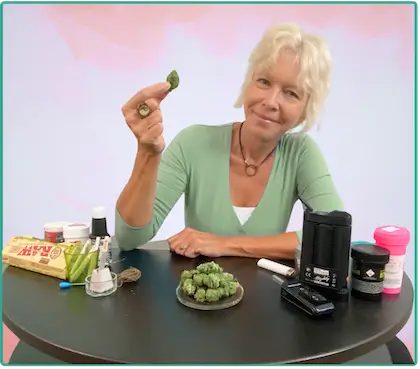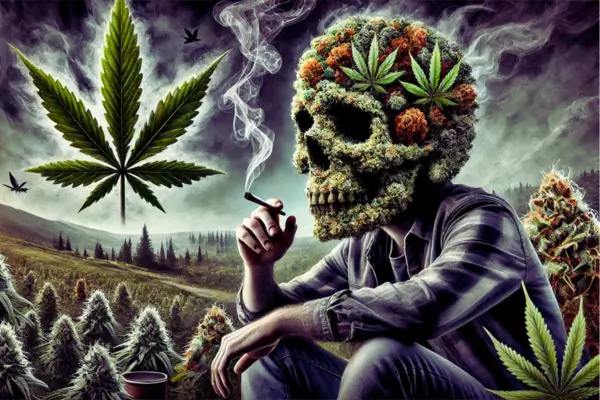I was flabbergasted – it was almost beyond belief.
Last week, the New York Times recited a litany of horror stories about cannabis causing severe health issues.
The article, As America’s Marijuana Use Grows, So Do the Harms (I’ve gifted the link so you can read it, in case you missed it) presented accounts from doctors, researchers, health officials and, most importantly, the people who take cannabis as a medicine for countless health issues, including anxiety and depression, migraines, relief from painful symptoms of cancer and AIDS (all mentioned in the NYT story).
The reason this take-down piece came as such a shock is that I’ve always revered cannabis as a potent plant medicine with the ability to support people on their healing journeys. (Personally, my journey with cannabis started all those many years decades ago in college when I discovered it helped alleviate my crippling anxiety.)

Of course, as a clinician, I’ve always been aware that – as with any agent for good – cannabis can also be problematic when overused or habitually used. But the overwhelming scale of the issue brought out in the NYT is startling.
I even asked my colleague and friend, Lex Pelger, a scientist who reviews and reports on cannabinoid science through his popular Substack blog, “Cannabinoids & the People”. I wanted his opinion on the article suspecting it might be a “hit piece” since the NYT has historically not been favorable towards the plant.
But Lex said, “Most people aren’t going to like my answer… It [the NYT article] seems fine to me. That’s about where the data lines up and these anecdotes match to what I’ve heard.”
The ugly truth of “crack cannabis”
The surge in severe health issues (such as anxiety, depression and psychosis) is frequently blamed on the escalating potency of the plant, which commercial growers have been steadily increasing to produce quicker, more intense highs. By comparison, according to the Times piece, what we used to smoke in the 1990s typically contained about 5% THC. Today’s products, like concentrates, can contain an astonishingly high THC content, reaching up to a staggering 90%, with flower as high as 30% (some cultivators claim it’s even higher).
This is why I personally refer to these products as “crack cannabis” and warn people to avoid it like, well, crack.
Often people I consult with about my emotional release work say they avoid using cannabis for medication or therapeutic purposes because it triggers overwhelming anxiety for them.* I believe it’s often (not always) because the THC content is too high.
The judicious use of this plant medicine has been a potent addition to my emotional and trauma release method for more than 10 years. It supports the deep inner exploration of buried emotions, processing and releasing them. I always suggest a ratio of at least twice as much CBD as THC. Many of my students, clients, and participants often go with even more expansive ratios… up to 20 times more CBD than THC. The CBD relaxes the fight or flight response while that little bit of THC amplifies the emotion(s) they want to work with. You can read more about it here.
Despite its massive critique, the NYT reporters did weave in a few acknowledgements of the plant’s benefits:
- Tens of millions of Americans use the drug, for medical or recreational purposes — most of them without problems.
- In interviews, they [doctors and researchers] acknowledged that marijuana can offer substantial health benefits for certain patients.
- While the drug can assist the endocannabinoid system, alleviate some symptoms of disease and otherwise make people feel good, regular heavy doses of it can also throw the system off balance.
What are your thoughts on this? Have you experienced the difference between the cannabis of back then and the cannabis of today? Drop down to the comments section and let me know!
With Love,
Becca
*when people work with me, if they wish to use an alternative plant medicine, we go with microdosing psilocybin.

What if these high levels of THC are allowing minds to tap into the Spiritual and energetic realms where things ACTUALLY ARE pretty scary unless trained and experienced? At these levels doesn’t it seem more like a psychedelic than say mood enhancer? Imagine people wanting to feel better or have a good time by smoking but instead have a go at the dark archetypes in the collective and or their own consciousness.
Hey Brock 💚 you make an excellent point!
As you know, I work with both therapeutic levels and psychedelic levels of plant medicines.
I\’ve held psychedelic cannabis gatherings. But there are a lot of people who don\’t have the tolerance for working with that much – it\’s definitely a subset of people, but we don\’t know who or how big a subset.
It\’s the same with psychedelics … a certain percentage (also unknown to date but upwards of 40% in a recent study) of people who have difficult lingering side effects from journeying. The question is always who will have problems? We don\’t know the answer, so it\’s really up to the individual to proceed with caution. For me as a guide and facilitator, I carefully screen my students and participants – for even microdosing. People need to feel safe and confident that they\’re in the hands of someone who\’s experienced and skilled. It\’s a huge responsibility and all bases should be covered.
You are spot on, of course, when you say that to handle these higher levels of THC, a traveler needs to be trained and experienced. Absolutely!
I used to have a lot of anxiety when I smoked cannabis, but this changed when I began to practice qigong regularly, which healed my kidneys and adrenal glands. I think the bad effect of cannabis says more about the chronic stress created by modern society than it does about the plant. If you think of cannabis as an amplifier, then if you are already emotionally, mentally or physically imbalanced you are going to have problems. If the THC content is high then one tends to smoke less. I remember back in the 70s when I was smoking lower THC weed that we would go through 3 or 4 joints to get to the point where one or two puffs will take you today.
Paul! Wise words. …. thru qigong you healed your kidneys and adrenals – and I’d suggest conditioned your nervous system so you could receive the strong energy coursing through your body (whatever you specifically call it – prana, chi, spiritus).
Re: the THC content, I usually suggest looking for a strain around 17%, which makes it easier to “start low, go slow – and don’t be afraid to go all the way”👌🏼
Very true about the potency available, vaping or smoking moderate amounts of fresh herb cannot be compared to using heavy concentrates which may need to be regulated.
Hi David! 😍 I don’t have answers but regulation is a dicey thing – and needs to be applied judiciously. Who’s going to do the regulating … a bunch of old white backward thinking (and ignorant about cannabis) Republican men or a variety of young, hip, informed Gen Y & Z’s? In Florida, the Republican-dominated state legislature wanted to cap flower at 10%.
Having said that, I do appreciate legalization that insists on “clean” canna. Even then it doesn’t always happen but at least the laws are in place with repercussions for those growers trying to slip the system.
Indeed. THC levels are out of control. I specifically look for the lowest THC level when enjoying the Sacred Herb. Nothing over 20% THC for me. Actually I prefer a 12-15% THC so as to not incur extreme anxiety from the high THC levels. Also, I find a high CBD mix with THC is very soothing, like a 1-1 ratio. Harlequin is a wonderfully soothing strain. It’s a challenge to find lower levels of THC at the Shops, but well worth my piece of mind and Sanity!
Gilbert, you could teach the “how to’s” of my canna prep session 😉 (that goes with every course I teach)! So much easier to “start low, go slow” when one is not blown away by Uber-percentage strains. Now, there are those (even among our commenters here) who like the “Blast me to the moon” strains but as pointed out those are for the seasoned cannanauts – not for those getting their feet wet. 🙏🏽
Pass the joint, please. And know your limitations. Just like any other drug, including alcohol, nicotine, narcotics, junk food, etc., it’s all within YOU to stop UNLESS you abuse, overuse, take to excess, and then that’s your own damn fault. Thanks for including the NYTimes article which I also find alarming, but certainly a cautionary tale.
Chill out and EXHALE. And as with everything, moderation is the key.
So funny Rose!🌹 “Pass the joint” … is that even a thing these days, post COVID? I mostly see people pulling from their personal vapes or “bogarting” their own “medicine stick”. (Bogarting – now there’s a term from the good ole days 🫣)
Pre-COVID when I was doing live in-person Cannabis Elevation Ceremonies in Denver (I’m doing a few online these days for those who want to hop on my interest list, (3rd panel down on the page).
I had this fabulous hookah where we passed the hose from participant to participant – I gave everybody a protective cover for the mouthpiece – as I liked to stay “germ-free” even back then (it’s just the clinician in me).
Anyway, you’re absolutely point-on, “moderation is key” … and if you’re going to go further, know thyself.